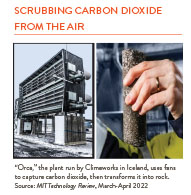Picture a factory that sucks carbon dioxide out of the air to reduce global warming, then turns it into stone. Well, it’s real, and it’s been operating outside of Reykjavik, Iceland since last September. It’s also been identified as one of the 10 breakthrough technologies of 2022 by the MIT Technology Review, which has been creating lists of top technologies since 2001.

It’s clear from the Technology Review’s recent lists that climate change, green energy, human health, AI, and data security are top of mind. While some of the breakthroughs may sound like science fiction, others have become so much a part of life that we’ve already started taking them for granted. For example, it’s easy to forget that mRNA vaccines, on the 2021 list, were such a stunning achievement. And this year’s list includes pills developed by Pfizer, Merck, and Pardes Biosciences to treat COVID. Pfizer’s Paxlovid reduces the risk of COVID-induced hospitalization by 89% — and it set the record for the fastest drug to move from new chemical to FDA approval.
A little farther from reality this year are practical fusion reactors. Cheap, “always-on,” carbon-free energy from fusion has been the dream for decades, but we have yet to build a reactor that produces more energy than it consumes. Still, the Technology Review thinks we’ve moved just a little bit closer now that Commonwealth Fusion Systems has developed a powerful 10-ton magnet to overcome a key engineering challenge for small reactors. MIT’s estimate on the availability of a practical fusion facility: about 10 years from now.
In the “not perfect” category is Mosquirix, the first malaria vaccine endorsed by the World Health Organization. Developed by GlaxoSmithKline, it’s a remarkable achievement, considering it’s been in testing since 1987. But Mosquirix is not really that great a vaccine: It requires children to get four doses at the right intervals, and one study found that efficacy against severe disease can drop by 50% the first year. Still, when combined with other mosquito and disease controls, the vaccine is expected to reduce deaths by as much as 70%. The other huge accomplishment is that Mosquirix is the first vaccine for a parasitic disease, which paves the way for vaccines for others.
Two other items on this year’s list are worth mentioning. One is AlphaFold2, the AI system developed by DeepMind (now owned by Google) that can accurately predict a protein’s 3D structure to the nearest atom. This is important, first, because protein structures are incredibly hard to figure out – an AI problem that DeepMind’s CEO Demis Hassabis has said is not too dissimilar from creating a program to beat a master at the ancient board game of Go (which DeepMind’s AlphaGo did in 2016). Second, proteins are key to almost everything that happens in our bodies, so knowing their structures is critical for disease research and drug discovery. DeepMind has created a public database of 800,000 protein structures, and it plans to add 100 million more in the next year – “nearly every protein known to science,” according to the Technology Review.

The other item is the factory in Iceland, mentioned above, that scrubs the air for carbon dioxide. The plant uses large fans to suck in air, binds the carbon dioxide to specialty materials, then transforms it into carbonate minerals mixed with basalt – and it runs exclusively on carbon-free geothermal energy (see photos). While the plant can take out only 4,000 metric tons of carbon dioxide a year — about the yearly emissions from 900 cars – it’s a start. Larger plants are in the works in British Columbia, the U.S. Southwest, Norway, and Scotland.